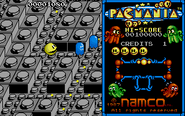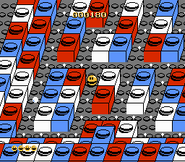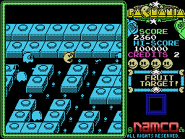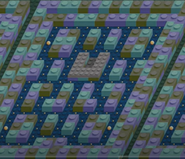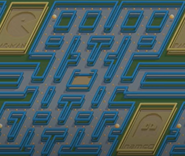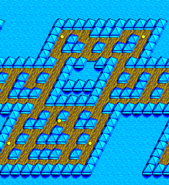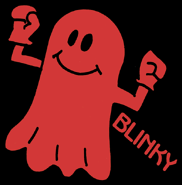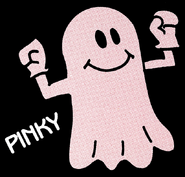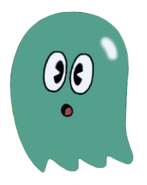Pac-Mania (パックマニア Pakku-Mania) is an arcade game released by Namco in 1987. It was the final Pac-Man arcade game to be released in the 1980s, though was eventually succeeded by Pac-Man Arrangement a decade later.
Gameplay[]
The core gameplay is more or less the same as the original Pac-Man. The player controls Pac-Man to eat all the Pac-Dots while avoiding ghosts. He can also get a Power Pellet in order to eat the ghosts, and can collect fruit for bonus points. When all dots are eaten, the player moves onto the next stage.
The most apparent difference in Pac-Mania is that the entire game is in an isometric, pseudo-3D perspective, which was very impressive for its time period. Pac-Man now also has the ability to jump over objects, including dots and ghosts (but not parts of the maze itself). This is a very useful move in tight situations, but it must be performed carefully.
Two new power-ups appear in the game as well, referred to as "Special Items", which appear occasionally in the center of the maze. The Pink Pellet will increase the points Pac-Man gets from eating ghosts, and will last until he loses a life. The Green Pellet makes Pac-Man go faster, but only lasts a short while.
Ghosts[]
Pac-Mania features the original four ghosts - Blinky, Pinky, Inky, and Clyde - along with Sue from Ms. Pac-Man and the newly-introduced Commons, Funky and Spunky. However, the red ghost (originally named "Blinky") is now named "Clyde", while the orange ghost (originally named "Clyde") is now "Blinky". Sue stays hot on Pac-Man's tail, unlike Clyde, who only does it in chase mode.
The first five ghosts have similar traits to their personas in Pac-Land and past appearances, while the newer Commons can jump when in Sandbox Land and Jungly Steps. Funky, the green common, is aggressive, but cannot jump as high as Pac-Man; thus, it is possible for the player to jump over them with proper timing. Spunky, the gray common, can jump just as high as Pac-Man, but is not nearly as aggressive as Funky. Unlike the other ghosts, there can be two of both Funky and Spunky, giving the player a chance of encountering a total of nine ghosts in later rounds.
The ghosts behave differently when attempting to reach a target position compared to other arcade games–rather than always taking what they perceive to be the optimal route, the ghosts will never turn at an intersection until they either have to or reach/pass their target. This means that if a ghost were following Pac-Man but not closely pursuing him, the player could make two quick turns into a different, parallel hallway traveling in the same direction, and the ghost would most likely keep going down the same hallway.
Some ghosts also tend to have smarter AI when Pac-Man eats most of the dots in a stage, or during the later stages of the game. This can be seen with Blinky in Pac-Man's Park, where he becomes much more aggressive than in the previous stage.
Regional differences[]
Several notable regional differences appear between the Japanese and international versions of the game:
- For unclear reasons, four (?) of the game's levels were removed from overseas releases (including the first stage in the Japanese original).
- In the international releases, the player automatically earns bonus points if starting from Pac-Man's Park or Sandbox Land (on the level select screen). In the Japanese version, no extra points are awarded.
- The overseas version features a high score initials screen, while the Japanese version does not.
- Various minor graphical and audio differences.
Arcade settings[]
The Pac-Mania arcade game features a rather large amount of game-controlling settings, which can cause some confusion between different variants and set-ups. This is especially problematic for home console ports, which will often be based on one random settings configuration without any option to change it. Some notable options that can be changed are:
- Level Count - A series of options to control how many levels a full game will last. In the Japanese version, it can be set to 11 rounds, 23 rounds, or loop infinitely. The North American version - due to flat-out missing certain levels in the first place - replaces the former two settings with 7 rounds or 19 rounds.
- Selection Screen - This setting allows the player to choose from any of the first three worlds on startup; can be turned on or off.
- Continue Screen - Allows the player to continue by inserting another quarter; can be turned on or off.
While the Japanese version does feature the Selection Screen and Continue Screen, they cannot be enabled simultaneously; this is not the case for the North American version.
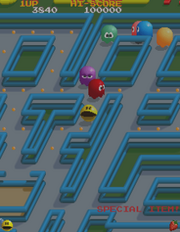
Gameplay (Pac-Man's Park)
Scoring System[]
- Pac-Dot - 60 points.
- Power Pellet - 300 points.
- Vulnerable Ghosts (normal):
- #1 in succession - 200 points.
- #2 in succession - 400 points.
- #3 in succession - 800 points.
- #4 in succession - 1600 points.
- #5 in succession - 3200 points.
- #6+ in succession - 7650 points.
- Vulnerable Ghosts (Pink Pellet):
- #1 in succession - 400 points.
- #2 in succession - 1600 points.
- #3+ in succession - 7650 points.
- Fruit
- 🍒 Cherry: 1000 points.
- 🍓 Strawberry: 2000 points
- 🍊 Orange: 3000 points
- 🍎 Apple: 4000 points
- 🍌 Banana: 5000 points.
- 🍑 Peach: 6000 points
- 🔔 Bell: 7000 points
- 🔑 Key: 8000 points
- 🍬 Candy: 4000 points
- 🍏 Green Apple: 6000 points
- ☕ Coffee: 5000 points
- 🍦 Chocolate Ice Cream: 8000 points
- 🍦 Vanilla Ice Cream: 8000 points
- 🔔 Silver Bell: 9000 points
 Galaxian Boss: 7650 points
Galaxian Boss: 7650 points- 🗝️ Silver Key: 10000
- 🍔 Hamburger: 7000 points
 Silver Galaxian Boss: 9000 points
Silver Galaxian Boss: 9000 points
Worlds[]
Pac-Mania has four worlds, each with their own intermission cutscenes and design attributes. Here is a brief description of each one.
Block Town[]
Main article: Block Town
This is an area made up of Lego-like objects. As the first stage, the ghosts are not too fast and no new ones are introduced (unless the game settings were changed, in which new ghosts may appear later on).
Maximum # of Ghosts: 5 (Blinky, Pinky, Inky, Clyde, and Sue)
Pac-Man's Park[]
Main article: Pac-Man's Park
This area is a 3D version of the original Pac-Man maze. The ghosts move at a speed a bit faster than Pac-Man's. Here, Funky is introduced, but he does not have his jumping abilities yet.
Maximum # of Ghosts: 7 (Blinky, Pinky, Inky, Clyde, Sue, and two Funkys)
Sandbox Land[]
Main article: Sandbox Land
This location appears to be set in a pyramid-like area. Here, the ghosts are even more aggressive. There is a warning in the introductory video to the level:
"COMMONS ARE PLAYING OUTSIDE. BEWARE OF JUMPING MONSTERS!"
Funky will now be able to jump, and two Funkys appear in the later two levels. Spunky makes her debut in the final level in this zone, and will be able to jump.
Maximum # of Ghosts: 8 (Blinky, Pinky, Inky, Clyde, Sue, two Funkys, and one Spunky)
Jungly Steps[]
Main article: Jungly Steps
The final world in the game. This world appears to be on a set of stairs, with curtains in the background. Pac-Man gets a significant boost in speed here, but so do the ghosts. Funky and Spunky are featured, and will jump.
Maximum # of Ghosts: 9 (Blinky, Pinky, Inky, Clyde, Sue, two Funkys, and two Spunkys)
Depending on the game settings, the game could end directly after Jungly Steps or loop back to Block Town for more rounds (at a higher difficulty).
Home Ports[]
- Acorn 32-bit
- Amiga
- Amstrad CPC
- Antstream
- Streaming service available on various platforms; uses the original arcade version.
- Arcade1UP Machines
- Many Arcade1UPs featuring Pac-Mania have been released (see this page for full list). There has been a directly Pac-Mania-themed machine produced as part of the "Legacy Edition" series. The game has also been included as an extra on other Pac-Man and Ms. Pac-Man cabinets.
- Atari ST
- Commodore 64
- Famicom/NES
- Developed by Westwood Associates and published by Tengen. While the game was licensed by Namco, it was not licensed by Nintendo.
- Game Boy Advance
- Included in Pac-Man Collection.
- All of the music tracks are heavily shortened. Additionally, "Jungly Steps" doesn't play its proper music track, instead playing the theme for "Block Town" again.
- GameCube
- Three versions were released, all of which are unlockable "bonuses" in other titles. The game was included in Namco Museum and Namco Museum 50th Anniversary, and was featured as a bonus game in Pac-Man World 2.
- iOS (iPhone, iPad, etc.)
- A standalone app released in 2010; it was removed from the App Store on March 30th, 2015.
- Features an additional "Scramble Mode", the exact details of which are unknown.
- Mobile
- MSX
- MSX2
- Nintendo Switch
- Two versions were released. The game was featured in Pac-Man Museum +, as well as being released standalone as part of the Arcade Archives series.
- PlayStation
- Included in Namco Museum Vol. 5.
- PlayStation 2
- Three versions were released, all of which are unlockable "bonuses" in other titles. The game was included in Namco Museum and Namco Museum 50th Anniversary, and was featured as a bonus game in Pac-Man World 2. In the Japanese version of 50th Anniversary (Namco Museum Arcade Hits!), Pac-Mania is unlocked by default.
- PlayStation 3
- Two versions were released. The game was included in Pac-Man Museum, and was featured in the PS one Classics release of Namco Museum Vol. 5.
- PlayStation 4
- Two versions were released. The game was featured in Pac-Man Museum +, as well as being released standalone as part of the Arcade Archives series.
- PlayStation Portable
- Featured in the PS one Classics release of Namco Museum Vol. 5.
- PlayStation Vita
- Featured in the PS one Classics release of Namco Museum Vol. 5.
- Plug & Play TV Games
- Several Plug & Plays featuring Pac-Mania have been released (see this page for full list). These consoles - being released past the Jakks Pacific era - generally feature the NES version of the game.
- Pocket Player (My Arcade)
- Included on the Pac-Man Pocket Player. Features the Sega Genesis version; for unknown reasons, the title screen is removed.
- Sega Master System
- Developed by TecMagik; only released in Europe and Australia.
- If the player completes the first level without eating any Power Pellets, a coin will appear in place of the Fruit. Eating this coin will reveal a secret "Coin World" which has the same layout from Block Town; this level is not seen in any other versions of the game.
- Sega Mega Drive/Genesis
- Developed by Sculptured Software and published by Tengen.
- The Pink Pellet's score multiplier only lasts on the round it's obtained on, rather than lasting throughout the game. It is unknown why this is the case, and it does not apply to any other port of the game.
- Sharp X68000
- Released exclusively in Japan (as was the X68000 platform as a whole), this port is dubbed "Pac-Mania - Extended Version for Superior Pacmaniacs". The subtitle was reportedly added due to the game incorporating certain features of the international arcade release (including the high-score table), while retaining all of the Japanese version's levels.[1]
- A bonus port of the original Pac-Man is included with the game.
- Wii
- Included in Namco Museum Remix and Namco Museum Megamix. The game was also released standalone as part of the Virtual Console Arcade line; this release was exclusive to Japan.
- Wii U
- Included in the Virtual Console release of Pac-Man Collection.
- Windows PC
- Pac-Mania has been released for Windows platforms in several forms: being included in titles such as Pac-Man World 2, Namco Museum 50th Anniversary, and Pac-Man Museum +.
- Xbox
- Three versions were released, all of which are unlockable "bonuses" in other titles. The game was included in Namco Museum and Namco Museum 50th Anniversary, and was featured as a bonus game in Pac-Man World 2.
- Xbox 360
- Included in Namco Museum Virtual Arcade and Pac-Man Museum.
- Xbox One/Xbox Series
- Included in Pac-Man Museum +.
- Zeebo
- Appears to be based on a preexisting mobile port (though it is unclear which). Oddly, it features similar UI to Namco All-Stars: Pac-Man, a Pac-Man PC port from around the same time period.
- ZX Spectrum
The majority of 80s and 90s home computer ports (save for the MSX2 and Sharp X68000 releases) were produced by Grandslam, and were only released in Europe and Australia (including Australasia territories).
Play Online[]
These versions of Pac-Mania are either listed in the public domain or are considered abandonware. Clicking the game title will lead you to a playable online version of it from archive.org (mobile compatibility may vary).
- Recommended: Pac-Mania (Sega Genesis, 1991)
- Pac-Mania (Sega Master System, 1991)
- Pac-Mania (ZX Spectrum, 1988)
Trivia[]
- Much of the music that plays in the game interpolates tracks originally from Pac-Man and Pac-Land.
- This is the first game in which Blinky and Clyde swapped their colors (see Clyde and Blinky error).
- The Sega Master System version of Pac-Mania was advertised in Europe on Supertext, a satellite TV channel that could only display Teletext. Due to the channel's inability to display actual video, a custom 8-bit sprite of Pac-Man was used.[2]



